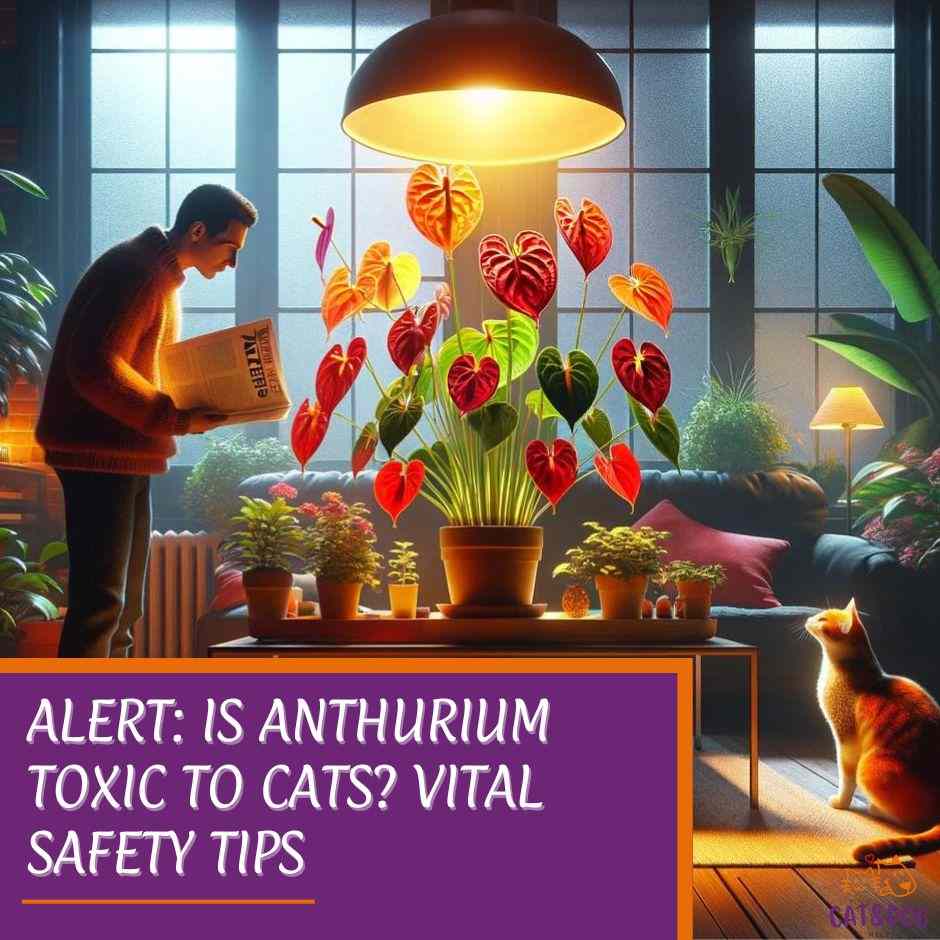Is Anthurium toxic to cats?
Have you ever found yourself admiring the vibrant, heart-shaped leaves and flamboyant blooms of the anthurium plant, also known as the “flamingo flower”?
While these exotic plants can add a splash of tropical flair to your home.
Understanding which plants are toxic to cats is crucial for pet owners, and anthuriums are among those plants that require careful handling to prevent accidental ingestion by our feline friends.
As a cat owner, it’s crucial to consider the safety of your curious feline friend around plants, especially tropical plants like anthuriums and philodendrons. (1)
Anthuriums, despite their stunning appearance, contain substances that can be harmful to cats.
When chewed or ingested, all parts of the anthurium plant release insoluble calcium oxalate crystals that can cause extreme discomfort and mouth pain for cats. (2)
These crystals can cause a variety of symptoms in cats, ranging from mild to moderate symptoms such as oral irritation, pain and swelling of the mouth, tongue, and lips, and excessive drooling.
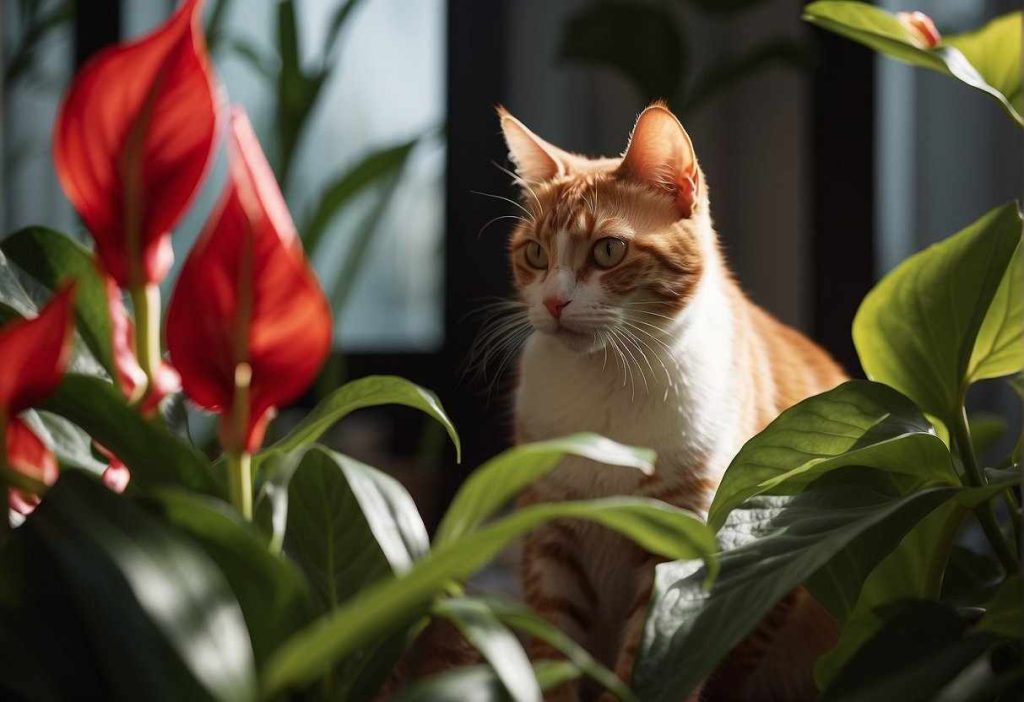
If your cat has eaten a lot of the plant, it’s important to seek veterinary care immediately.
Knowing this, you need to keep anthurium plants out of your cat’s reach, ensuring that your home remains a haven for your four-legged companions.
Key Takeaways
- Anthurium plants are toxic to cats due to insoluble calcium oxalate crystals.
- Symptoms of ingestion in cats can include mouth irritation, vomiting, and drooling.
- Keeping anthurium plants out of cats’ reach is crucial for their safety.
Is Anthurium Toxic to Cats?

What Makes Anthurium Toxic to Cats? Anthuriums contain insoluble calcium oxalate crystals that are the real troublemakers.
These crystals are like microscopic needles, and when your cat chews any part of the plant—be it the leaves, stems, or blooms—they can cause immediate irritation. (3)
The Physiological Impact of Toxicity on Cats: When those pesky crystals find their way into your kitty’s mouth, they can cause:
- Oral irritation and swelling
- A burning sensation in the mouth
- Difficulty swallowing
Recognizing Symptoms of Anthurium Poisoning: Keep an eye out for these troubling signs if you suspect your furry friend has nibbled on anthurium:
- Oral Symptoms:
- Drooling
- Swelling of the lips, tongue, and oral cavity
- Gastrointestinal Signs:
- Vomiting
- Decreased appetite
Remember, these symptoms are signs that your cat is not having a good time and needs your help. No jokes here, it’s serious business. So, if you see signs of distress, contact your vet pronto. (4)
In short, keep your beloved anthuriums well out of paw’s reach. It’s in the best interest of your furry family member’s well-being.
Immediate Actions for Anthurium Ingestion
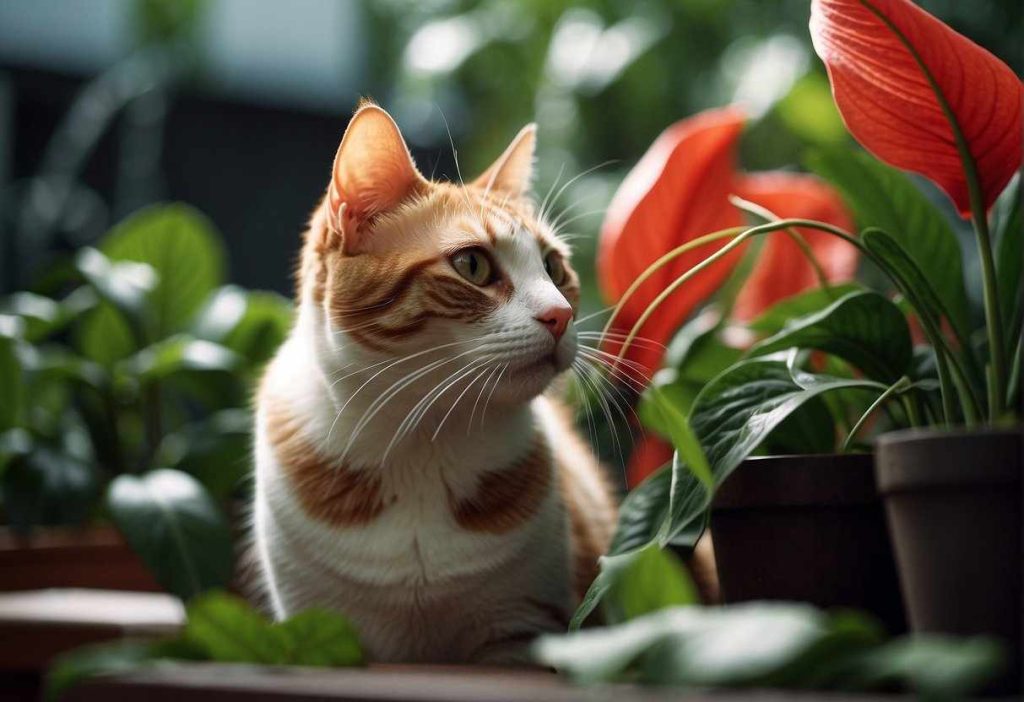
Found your furry friend nibbling on Anthurium? Here’s how to spring into action:
Emergency Steps to Take
- Remove any plant material: Gently take any remaining parts of the plant out of your cat’s mouth to prevent further ingestion.
- Rinse their mouth out: Only if your cat will allow it, softly rinse their mouth with water to help relieve irritation.
Quick, actionable advice for immediate care
- Assess their symptoms: Check for drooling, pawing at their face, or signs of oral discomfort.
- Stay calm: Your furry buddy needs you to be their rock.
When and how to contact a veterinarian
- Immediate call: As soon as you notice any symptoms, even mild, get on the phone with your vet.
- What to say: Inform them about the Anthurium incident and any symptoms you’ve noticed.
Professional Veterinary Response and Care
Time is of the essence, so let’s get them to the pros.
- Transport to the vet: Secure your cat in their carrier and head to the veterinary clinic.
What to expect at the vet
- Your vet will likely give your cat a thorough physical exam and may induce vomiting or give activated charcoal to prevent toxin absorption.
Importance of expert evaluation and treatment
Why rush to the vet? It’s the surest path to peace of mind—they’ll assess the situation, minimize risk, and provide essential care to keep your cat purring.
Remember, prompt action can make all the difference, so don’t hesitate to seek the help of a professional!
Long-Term Health Monitoring and Care
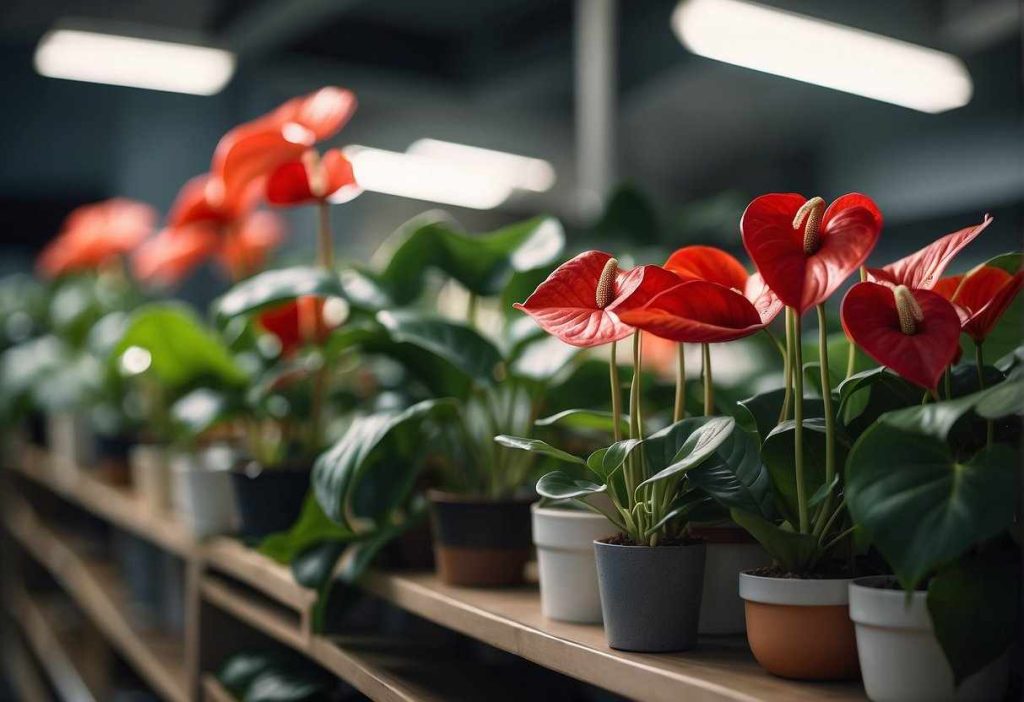
After your feline friend’s curious nibble on an anthurium plant, stay on alert—even post-emergency care. You’ve done the right thing by getting prompt treatment, but what happens next? Aftercare is essential.
Let’s look at some steps to keep your fuzzy companion happy and healthy!
Home Care Post-Emergency Treatment:
- Remove the plant: First thing’s first, remove any anthurium plants to prevent future incidents.
- Comfort: Provide a quiet space for your cat to rest, with comfy bedding and minimal stress.
- Hydration: Encourage your cat to drink water. A hydrated kitty is a healthy kitty! (5)
Signs to Watch For:
- Positive Signs:Normal eating and drinking habits
- Usual level of activity and playfulness
- Warning Signs:Continued vomiting or diarrhea
- Persistent drooling or pawing at the mouth
- Changes in urination or thirst (could suggest kidney issues)
Follow-up Veterinary Visits:
- Schedule a follow-up appointment to ensure everything’s on track. Your vet may suggest bloodwork or additional treatments if needed.
Wrapping It Up:
- Remember, only you know your pet best. If something seems off, don’t hesitate to reach out to your vet. A quick call or visit can bring peace of mind and keep your furry pal on the path to a full recovery. Sweet dreams to your kitty as they cozy up, far away from those pesky plants!
Preventing Anthurium Exposure
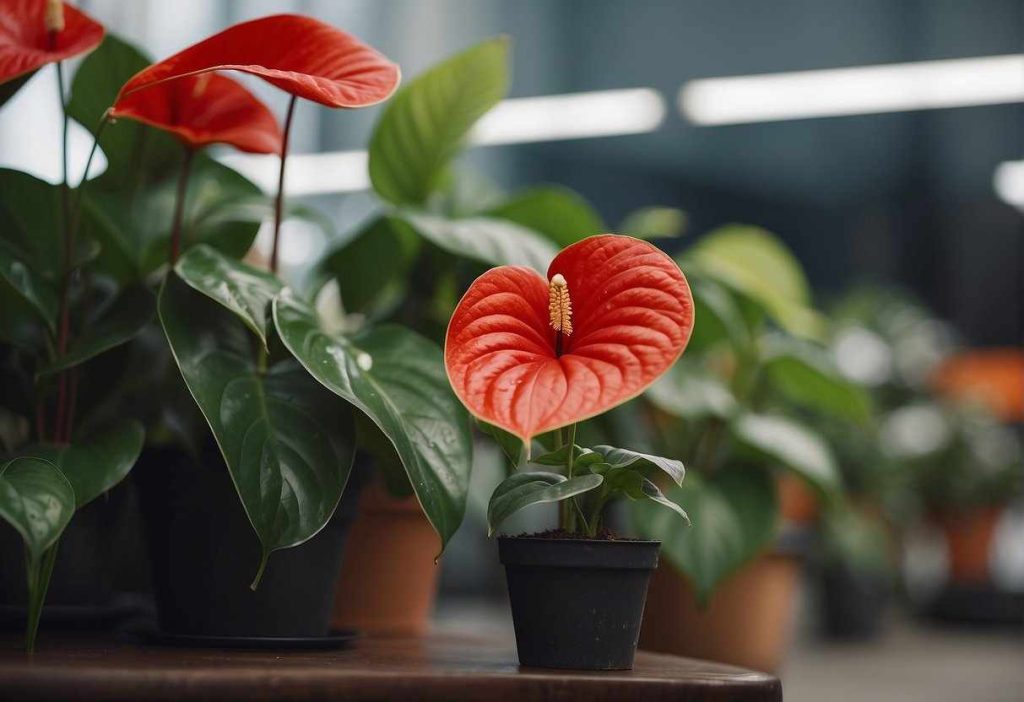
Safe Plant Placement and Pet-Proofing Strategies:
- Elevate Your Plants: Think tall plant stands, shelves, or even hanging planters. Cats might be acrobats, but if it’s out of sight, it might just be out of mind.
- Close off the Plant Room: If you have a spare room, make it a green sanctuary that’s off-limits to your cat with a simple sign, “No Kitties Allowed!”
Got a persistent prowler? Try these deterrents:
- Use natural deterrents like citrus peels or sprays around your anthurium.
- Install pet-proofing barriers that block access to plant areas.
Selecting Safe Houseplant Alternatives: Why risk it, right? Load up on these feline-friendly greens instead:
| Safe Plants | Benefits |
| Spider Plant | Air-purifying, easy to grow |
| Boston Fern | Lush, provides humidity |
| Areca Palm | Tropical vibes, non-toxic |
Remember, choosing these safe plants means you can breathe easy, knowing your cat can nibble without any nasty side effects.
In a nutshell: Keep those anthuriums out of paw’s reach, use smart barriers, and maybe gift your kitty some safe greenery. They get their jungle, and you get your peace of mind. Win-win!
In addition to safeguarding your pets from toxic plants like anthuriums, implementing measures for preventing moth ingestion is crucial, as moths can carry harmful toxins if consumed by your feline friends
Expert Insights and Community Experiences
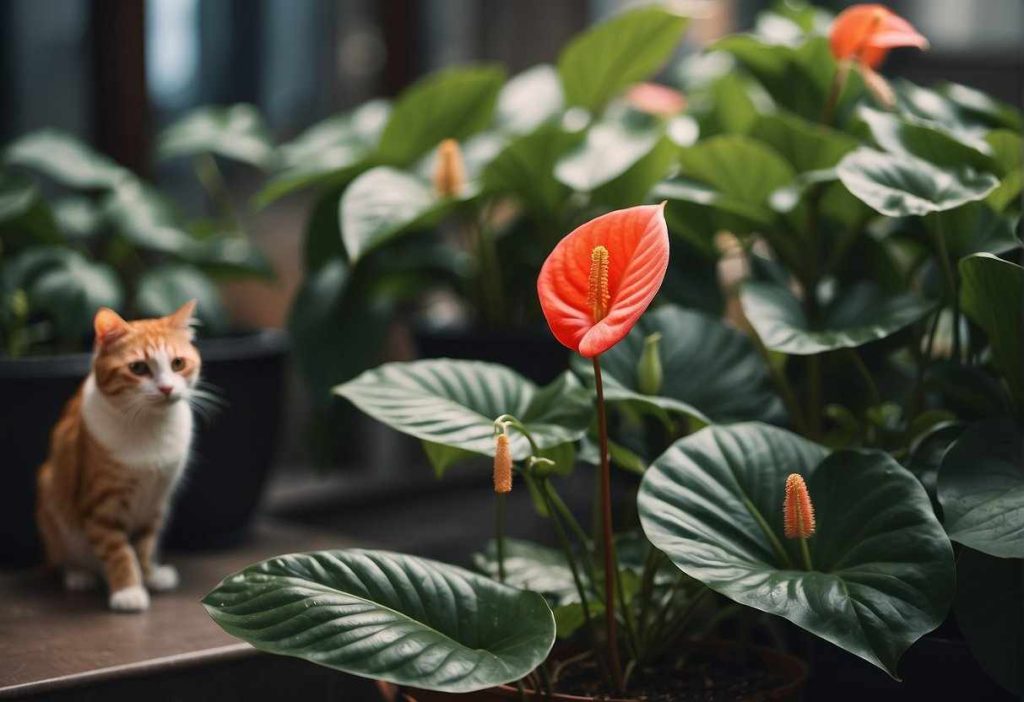
Vet-Approved Prevention and Care Tips
Anthuriums contain calcium oxalate crystals, which can cause some nasty reactions if ingested, such as poisoning. (6)
However, there are alternatives to these poisonous plants that are safe for pet parents to have in their homes, such as non-toxic plants with beautiful foliage.
In addition, these compatible plants will provide joy in the house to decorate your living space.
If you suspect your cat has ingested a toxic plant, it is important to contact your veterinarian or the pet poison helpline for expert advice and assistance.
- Irritation and swelling in the mouth
- Difficulty swallowing
- Excessive drooling
So, what’s a concerned cat owner to do? Take it from the experts:
- Keep plants out of paw’s reach: Elevate or isolate your Anthuriums.
- Go artificial: Love the look? Opt for faux Anthuriums to keep your decor lively and kitty safe.
Incorporating Quotes and Advice from Veterinarians
Veterinarians stress the importance of steering clear. Dr. Whisker says, “An ounce of prevention is worth a pound of cure when it comes to pets and toxins.” Taking these small steps can help avoid emergency vet trips.
Discussing the Role of Toxicologists in Pet Health
Toxicologists play detective, identifying harmful substances. They’d give a stern nod to keeping your Anthuriums and cats apart. After all, they know firsthand the risks involved.
Real-Life Stories and Community Advice
Joined a pet forum recently? You’ll find tons of stories and advice from other pet owners. Here’s one: “My cat nibbled on an Anthurium leaf, and the vet visit was both scary and pricey.
Never again!” Warn others and share your experiences to build a savvy pet community.
Engaging with the Community Through Comments or Forums
Remember, pet communities are treasure troves of wisdom. Seek advice and share your own tips. Your experience could be the word of caution another cat lover needs.
Got a funny story about your cat and plants? Share it! Laughter is just as important as education.
Quick Recap
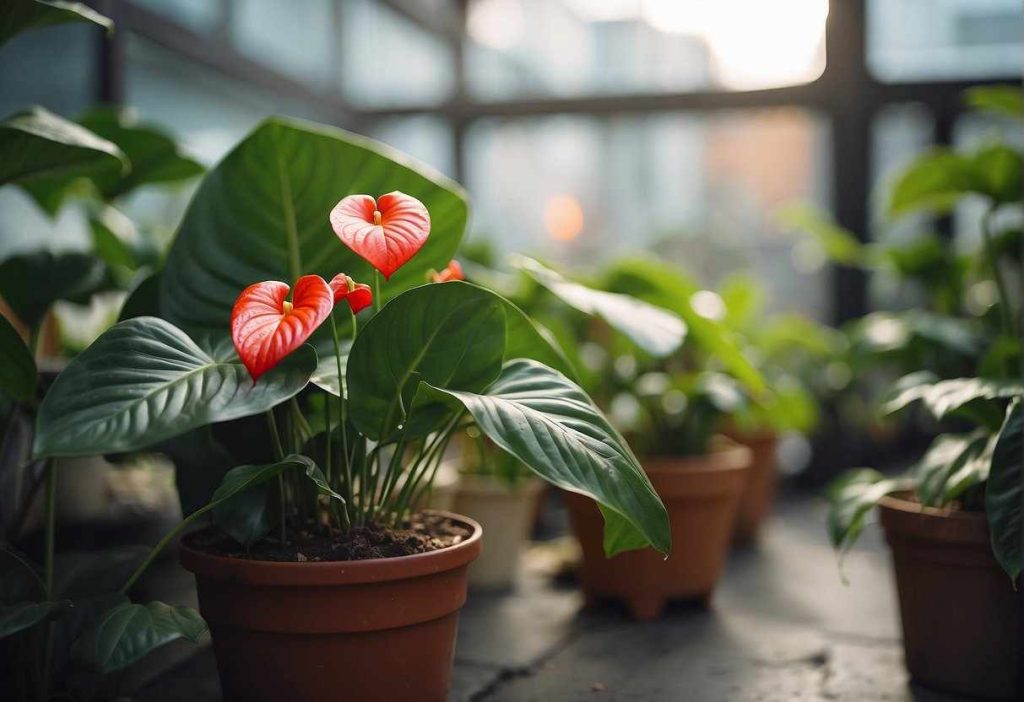
Here’s what you need to watch out for if you have these plants at home:
- Toxic Parts: Every single bit of the anthurium plant poses a risk—roots, stems, leaves, flowers, and seeds included.
- Culprit Compounds: The troublemakers are calcium oxalate crystals, which can be harsh on your cat’s system.
- Symptoms Can Include:Oral irritation
- Swelling in the mouth
- A burning sensation on the tongue and lips
- Excessive drooling
- Vomiting
- Difficulty swallowing
How do cats get exposed? It’s simple, really. Cats are curious by nature and may nibble on plants.
However, the sharp texture of those calcium oxalate crystals is like a microscopic cactus party in their mouth—not fun at all!
Quick Actions: If you suspect your cat has chewed on anthurium, don’t wait—contact your vet immediately. It’s always better to be safe than sorry when it comes to your furry family members.
Remember, avoiding exposure is key. Consider placing your anthurium plants out of reach or opting for cat-safe greenery. Keep an eye on those sneaky paws—our feline friends are known for their acrobatic feats!
For more detailed information, it’s always a good idea to check out Catster’s vet-approved facts, or delve deeper into the topic with resources like the ASPCA’s list of toxic and non-toxic plants.
Your awareness of potential hazards, such as plants containing toxic pollen, could be the superpower that keeps your cat safe and sound. Stay informed, stay vigilant, and give your pet a happy, hazard-free home!
Keep an eye out for signs that your cat may have ingested toxic pollen, such as excessive drooling, vomiting, difficulty swallowing, and eye pain.
Frequently Asked Questions
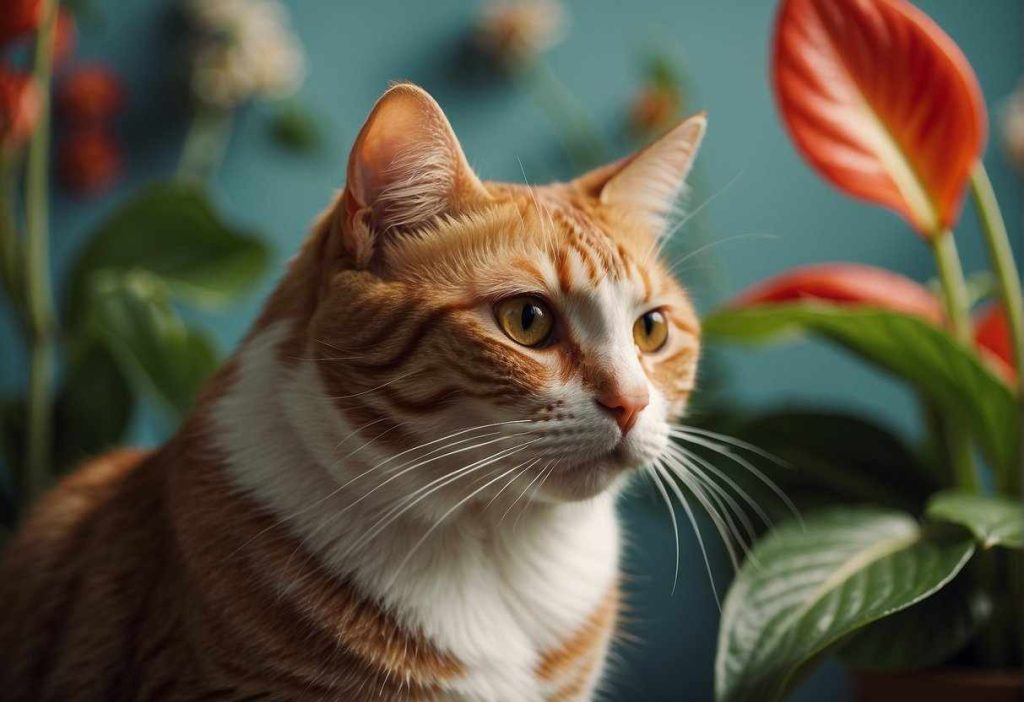
If you’re a cat owner with a love for houseplants, understanding the risks of anthurium to your feline friend is crucial. Here’s a quick guide to some of the most common questions you might have.
What immediate steps should I take if my cat ingests Anthurium?
If you catch your cat nibbling on an anthurium, wash out their mouth with water gently to remove any plant material.
Contact your veterinarian or a pet poison hotline right away, as prompt action is key to mitigating the effects of poisoning.
How can I tell if my cat has been poisoned by Anthurium?
Watch for signs like vomiting, drooling, and difficulty swallowing.
These symptoms can appear shortly after ingestion since the calcium oxalate crystals in the plant can cause immediate irritation to your cat’s mouth and GI tract.
Are all parts of the Anthurium plant toxic to cats?
Yes, all parts of the anthurium plant contain calcium oxalate crystals, which are harmful to cats.
Even small amounts can be problematic, so it’s best to keep these plants out of reach.
What are some cat-safe alternatives to Anthurium plants?
If you’re looking to green up your space without harming your cat, consider cat-safe plants like Boston ferns, spider plants, and bamboo palms.
These are non-toxic and just as vibrant!
Can Anthurium poisoning in cats be treated at home?
It’s not advisable to treat anthurium poisoning at home as symptoms can escalate. Always seek professional veterinary care to ensure the well-being of your cat.
How long after ingesting Anthurium will a cat show symptoms?
Symptoms can develop quickly, typically within a few minutes to hours after ingestion.
If you suspect your cat has eaten part of an anthurium plant, don’t wait for symptoms to show before seeking help.
What long-term effects can Anthurium poisoning have on a cat?
While anthurium poisoning is typically not fatal, if left untreated, it can cause significant discomfort and potentially lead to dehydration due to vomiting or diarrhea.
Always consult a veterinarian to avoid any long-term health issues.
- Free Online Casino Games: What You Need to Know - July 26, 2025
- Ideal Casinos Mobile: The Ultimate Guide to Mobile Betting - July 26, 2025
- The Ultimate Overview to Casino Site Gamings Online - July 26, 2025

